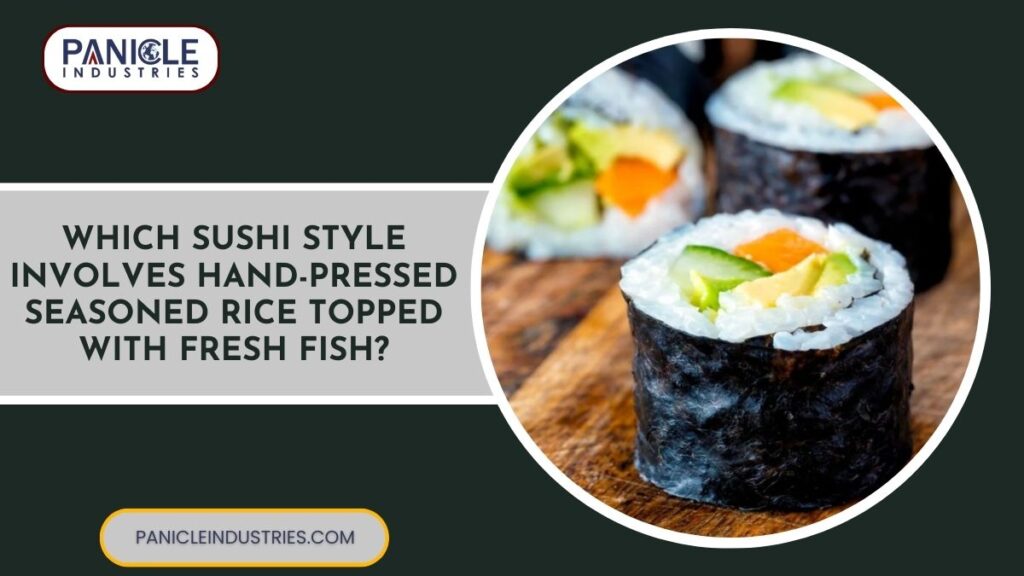Sushi is one of the most popular Japanese dishes enjoyed worldwide for its simplicity, freshness, and flavor. While there are different types of sushi, one of the most common questions people often ask is: which sushi style involves hand-pressed seasoned rice topped with fresh fish? The answer to this question is Nigiri Sushi. This style of sushi is simple yet elegant, consisting of a small mound of seasoned rice gently pressed by hand and topped with a slice of fresh fish or seafood. Nigiri is widely loved because it highlights the natural taste of the fish while balancing it with lightly seasoned rice.
In this blog, we will explore everything about Nigiri sushi, its history, preparation, variations, and common mistakes to avoid.
What is Nigiri Sushi?
Nigiri sushi is one of the purest forms of sushi. The word Nigiri comes from the Japanese verb “nigiru,” which means “to grasp” or “to press with the hand.” This perfectly explains the preparation style—hand-pressed seasoned rice topped with a slice of raw or cooked fish. Unlike sushi rolls, Nigiri focuses on simplicity. It allows the natural flavors of the fish to shine without being hidden by seaweed or heavy sauces. Nigiri is often served in pairs and sometimes garnished with a small dab of wasabi between the rice and fish.
Also read: Why Does My Rice Cooker Take So Long to Cook Rice?
A Brief History of Nigiri Sushi
Nigiri sushi has its roots in Tokyo during the early 19th century. At that time, sushi was mainly preserved fish fermented with rice. However, street food vendors in Edo (modern-day Tokyo) created a quicker version by placing fresh fish on top of vinegared rice. This became known as Edomae sushi, meaning “in front of Edo,” because it used fresh fish from the Tokyo Bay area. Nigiri quickly became popular because it was delicious, quick to prepare, and easy to eat. Over the years, it spread across Japan and later the world, becoming the sushi style most people recognize today.
How Nigiri Sushi is Made
Making Nigiri sushi may look simple, but it requires skill and precision. The basic process involves:
- Preparing the rice – Sushi rice (called shari) is cooked and seasoned with a mix of rice vinegar, sugar, and salt.
- Shaping the rice – A small portion of rice, about the size of two fingers, is gently pressed by hand into an oval shape.
- Adding wasabi – A small dab of wasabi may be placed on top of the rice to enhance the flavor.
- Placing the topping – A thin slice of fresh fish or seafood, known as neta, is laid over the rice.
- Final touch – Sometimes, a thin strip of seaweed is wrapped around to hold the topping in place.
Popular Fish Used in Nigiri Sushi
The choice of fish plays a very important role in Nigiri sushi. Some of the most common and popular options include:
- Tuna (Maguro) – A classic choice that comes in different cuts such as lean, medium fatty, or fatty tuna.
- Salmon (Sake) – Loved for its rich flavor and smooth texture.
- Shrimp (Ebi) – Usually boiled before being placed on rice.
- Yellowtail (Hamachi) – A mild, buttery fish popular in sushi restaurants.
- Eel (Unagi or Anago) – Cooked eel often glazed with a sweet soy sauce.
- Octopus (Tako) – Slightly chewy but flavorful.
Each topping brings a unique taste and texture, making Nigiri versatile and enjoyable for everyone.
Differences Between Nigiri and Other Sushi Styles
Many people confuse Nigiri with other sushi types, but they are quite different. Here are some key differences:
- Nigiri vs. Maki (sushi rolls) – Maki involves rolling rice, fish, and vegetables in seaweed, while Nigiri is hand-pressed rice with fish on top.
- Nigiri vs. Sashimi – Sashimi is simply sliced raw fish without rice, while Nigiri always includes rice.
- Nigiri vs. Temaki – Temaki is a hand roll shaped like a cone, wrapped in seaweed. Nigiri is small and oval-shaped.
These differences show why Nigiri is unique—it is minimal yet flavorful.
Why People Love Nigiri Sushi
Nigiri sushi remains popular worldwide because of its balance of taste and texture. Here are some reasons why people love it:
- Freshness – It highlights the natural flavor of fresh fish.
- Simplicity – No heavy sauces or fillings, just rice and fish.
- Health benefits – Nigiri is rich in protein, omega-3 fatty acids, and low in calories.
- Cultural experience – Eating Nigiri connects people to traditional Japanese cuisine.
For sushi beginners, Nigiri is often the best place to start since it represents authentic Japanese sushi in its purest form.
Common Mistakes to Avoid When Making Nigiri Sushi
Even though Nigiri looks simple, beginners often make mistakes while preparing it. Some common mistakes include:
- Using regular rice instead of sushi rice – Only short-grain sushi rice has the right stickiness.
- Pressing the rice too tightly – This makes the rice hard instead of light and fluffy.
- Using fish that is not fresh – Freshness is the key to Nigiri. Always choose sushi-grade fish.
- Adding too much wasabi – A small amount is enough; too much can overpower the flavor.
- Cutting fish incorrectly – Thin, even slices are essential for balance.
Avoiding these mistakes will help you create authentic Nigiri sushi at home.
Variations of Nigiri Sushi
Though traditional Nigiri uses raw fish, many variations exist to suit different tastes:
- Cooked toppings – Shrimp, eel, and octopus are often cooked.
- Vegetarian Nigiri – Toppings like avocado, tamago (sweet egg omelet), or pickled vegetables.
- Fusion Nigiri – Modern chefs sometimes add sauces, searing techniques, or unique toppings like truffle.
These variations make Nigiri more versatile and suitable for people who may not prefer raw fish.
How to Eat Nigiri Sushi Properly
In Japanese culture, there is an etiquette for eating Nigiri sushi:
- Use your hands or chopsticks – Both are acceptable.
- Dip fish side, not rice side, in soy sauce – This prevents the rice from soaking too much sauce.
- Eat in one bite – Nigiri is designed to be eaten whole.
- Respect the chef’s work – Appreciate the balance of rice, fish, and seasoning without adding too much extra sauce.
Following these customs enhances the experience and respect for traditional Japanese dining.
The Global Popularity of Nigiri Sushi
From Tokyo to New York, Nigiri sushi is served in restaurants worldwide. Its popularity continues to grow because it represents both tradition and simplicity. Many high-end sushi bars specialize in Nigiri, offering seasonal fish that showcase freshness and quality. At the same time, casual restaurants also serve Nigiri, making it accessible to everyone. This balance of tradition and modernity makes Nigiri a timeless favorite among sushi lovers.
Conclusion
If you have ever wondered which sushi style involves hand-pressed seasoned rice topped with fresh fish?, the answer is Nigiri sushi. Simple yet elegant, Nigiri combines perfectly seasoned rice with fresh fish to create a dish that highlights natural flavors. It is loved for its authenticity, health benefits, and balance of taste. From traditional tuna or salmon toppings to modern fusion variations, Nigiri offers something for everyone.
By learning its history, preparation methods, and cultural etiquette, you can appreciate it even more. Whether enjoyed in a fine Japanese restaurant or made at home, Nigiri sushi remains a true symbol of Japanese culinary tradition.


